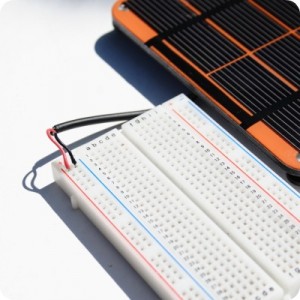How much solar power am I generating?
A solar panel does not do anything in isolation. It needs to be connected to something. That something is called a load. A load dissipates power and converts electrical energy to work.
We’re going to make a simple circuit where we connect a solar panel to a resistor. The resistance changes the behavior of the panel. The more resistance, the higher the Voltage but the lower the current. The lower the resistance, the lower the Voltage and higher the current. What we’re looking for is point where the panel produces the most power.
In this tutorial, you’ll need:
- 2 solar panels
- multimeter
- breadboard
- a range of resistors
- Voltaic circuit box (optional)
1. Measure Voltage and current through multiple resistors: If you haven’t already, strip the leads on your panel and connected them directly into the breadboard as shown below. Re-measure both the open circuit Voltage and short circuit current.
Then, connect a resistor to create a simple circuit and measured both the Voltage across the resistor and current through the resistor.
2. Repeat using a variety of resistors – create a table like below (we used 8 different resistors)
| Resistance (Ohm) | Voltage (V) | Current (A) | Power (Watts) |
| Open Circuit | 6.53 | 0.0 | 0.0 |
| 240 | 6.46 | .03 | 0.19 |
| 120 | 6.4 | .06 | 0.38 |
| 62 | 6.27 | .1 | 0.63 |
| 27 | 5.82 | .22 | 1.28 |
| 15 | 4.65 | .32 | 1.44 |
| 6.8 | 2.19 | .33 | 0.7 |
| 4.7 | 1.5 | .33 | 0.50 |
| 1.5 | 0.6 | .33 | 0.20 |
| Short Circuit | 0 | .33 | 0.0 |
3. Graph it! If you graph the Voltage and current on a scatter plot, it will look something like this:
The peak power output of the panel is at the “elbow” of the curve and looks to occur at a bit less than 5V and 0.31 Amps. At this point in time, we’re getting then about 1.5 Watts out of our 2 Watt rated panel.
Wait, does that mean the specs are wrong? No, it just means that there are factors that decreased the output on this particular day. There were two major issues:
- It was a 90 degrees (Farenheit) – solar panels get less efficient at high temperatures. In Tutorial 3, we’ll show you what happens when you submerge panels in an ice bath before measuring power output
- It was a slightly hazy New York City day – meaning we weren’t getting all the sunpower that we would have received in a less humid environment.
You should see that when you put two panels in parallel, the Voltage stays the same and the current doubles. When you put the panels in series, the Voltage doubles and the current stays the same. Overall, you get twice the power.
Note: the half a Volt drop in Voltage is from the diode in the circuit box. Extra credit if you spotted that.
Continue onto Part 3 of our Tutorial – How (and why) do I store power? In this tutorial we explain how to store solar energy in batteries for use when there is no sunlight available.
Skip ahead to Part 4 of our Tutorial – How do charge circuits protect batteries? In this tutorial we explain how built-in circuits protect both our batteries and your devices.
Review Part 1 of our Tutorial – How do solar chargers work? Understanding the basics of generating solar electricity and how to measure Voltage and Current in different conditions.
This post was updated from the original post in September 2011.











The chart above has a column for current… it is labeled as mA… but it is in Amps.
You’re right. Corrected.
Hi, My name is Jett Trudeau. I am a senior in high school and am currently producing my science fair experiment for this year. I am trying to measure the voltage and current of a some solar cells. I am about to buy a multimeter, and I have three solar cells already. Is there anything else I need? Thank you so much.
To measure “open circuit” Voltage, that is all you need. To measure current and Voltage under load, you have to have something for the panels to flow into like a battery.
It is an awesome project.. As this charger makes use of non-conventional source of energy, it will save minimum of 11 watts a day.. and I would b happy, if u can send me the complete details about this project.. I would b grateful, if u suggest me some other topic to do my project.
thank u